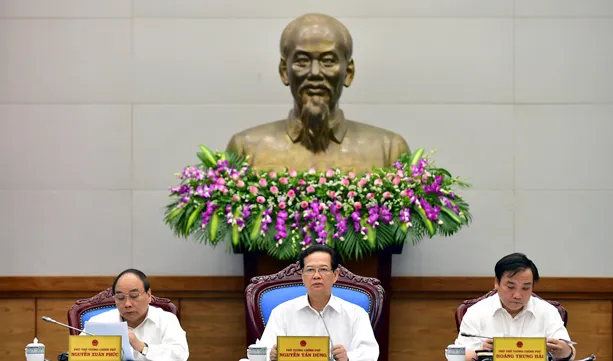PM presents socio-economic situation at NA session

According to the report, 13 out of the 14 socio-economic development targets set for 2015 in an NA resolution are expected to be reached or exceeded. The sole unreachable aim relates to forest coverage.
The report stated that the nation’s socio-economic situation in the first nine months of this year continued to recover with numerous positive results. Macro-economy was essentially stabilised and inflation was curbed at a low level.
September’s consumer price index (CPI) rose by 0.4% against December 2014, bringing the average index from January-September up 0.74% compared to the same period last year – the lowest rate increase in the past 15 years.
Total outstanding credit is estimated to increase 10.78%, nearly 1% higher than the deposit growth rate, which shows improvement in clearing credit capital for business and investment development.
In the period, VND683 trillion (US$30.7 billion) was contributed to the State budget, equal to 75% of the yearly estimate and up 7% year-on-year. Revenue from oil and import-export activities were low, only equal to 55.7% and 70.5% of the yearly estimates, which was attributed to decreases in the prices of crude oil and several commodities.
Meanwhile, State budget spending was VND823.97 trillion (US$37.07 billion), or 71.8% of the estimate and up 7.8% year-on-year.
The Government leader also pointed to shortcomings and difficulties in the country’s socio-economic situation. Labour productivity and the quality, efficiency and competitiveness of the economy remained low.
State budget overspending was high while public debt rose rapidly; bad debt has yet to be handled and trade deficits rose again. The market economy institutions improved, but slowly, and corruption persists.
Based on the five-year socio-economic development plan for 2016-2020, the Government drew up several general targets for next year with the aim to maintain macro-economic stability, strive for higher economic growth, improve growth quality and ensure sustainable development.
Several targets, expected to be submitted to the National Assembly for approval, include a GDP growth rate of 6.7%, a CPI increase rate of below 5%, a decrease of 1.3-1.5% in poverty rate and the proportion of population using health insurance reaching 76%.
During the October 20 sitting, NA deputies also heard Chairman of the Vietnam Fatherland Front (VFF) Central Committee Nguyen Thien Nhan’s report on voter opinions.
In preparation for the 13th NA’s 10th session, the VFF Central Committee and the NA Standing Committee collected 4,492 ideas and recommendations from voters nationwide.
The report revealed growing concern from voters nationwide over a number of shortcomings such as unsustainable economic development, sluggish equitisation of State-owned enterprises, persistent corruption and limited growth speed and labour productivity.
Voters also took interest in other issues related to environmental pollution, food safety, social evils, traffic and fire accidents, disasters and rising sea levels.
Voters expressed their indignation with China’s illegal construction of facilities at sinking islands and reefs that belong to Vietnam’s sovereignty, the report said.
They paid special interest in progress on personnel preparations for the 12th National Party Congress and hoped individuals elected to hold key positions in the Party and all-level authorities would promote high professionalism, good virtues and strong political character, contributing to making the Party stronger and unblemished.
The National Assembly (NA), the NA Standing Committee and the Vietnam Fatherland Front were urged to increase their role in inspecting and directing ministries and sectors to carry out their assigned functions while remaining accountable to the people.
At the end of the morning sitting, the NA heard a report delivered by Head of the National Assembly's Committee for Economic Affairs Nguyen Van Giau, which assessed the implementation of the NA’s Resolution on socio-economic development plans in 2015 and 2016, and results reaped from 2011-2015.
The report stressed that Vietnam has yielded important outcomes over nearly all fields, essentially fulfilling socio-economic development goals set for 2015.
However, it also revealed shortcomings in the limited quality, efficiency and competitiveness of the national economy; tumbling output and export values of the agricultural sector; and difficulties in consumption seriously impacting producer income, especially farmers.
Some social problems persist, including the rise of serious criminal cases. Efforts to safeguard national sovereignty in seas and islands are coping with new difficulties and challenges whilst administrative reform, anti-corruption and wastefulness prevention have yet to meet the set demand, the report noted.
The NA’s Committee for Economic Affairs concurred with measures to promote socio-economic development in 2016 put forth in the Government report. It suggested the Government continue implementing the 2013 Constitution, fine-turning the legal system and removing delays in issuing documents guiding the enforcement of laws.
The committee asked the Government to design more flexible monetary and fiscal policies, focus efforts on resolving difficulties facing enterprises, intensify measures to support goods consumption and promotion, improve the trade imbalance with China, effectively settle bad debts and strictly control public debt and advance disbursement for capital construction.
They also underlined the need to attract foreign-invested projects using advanced technologies to increase added value for exports and push the implementation of a VND30 trillion credit package to support the construction and purchase of social housing in order to not only satisfy increasing demand in the field and also stimulate recovery in the real estate market.





